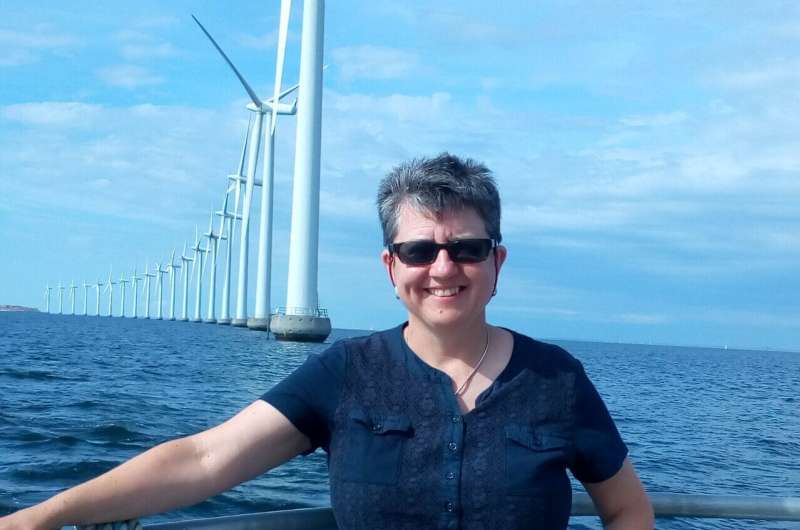Professor Sara C. Pryor at the Middlegrunden Offshore wind farm in Denmark. Credit: Sara C. Pryor.
Over the past few decades, researchers have developed increasingly advanced technologies that convert natural sources into electrical energy through the use of solar cells and wind turbines. Recently, the wind energy industry has been expanding rapidly, with a growing number of companies and governments investing in the use of wind turbines and other wind energy converters.
The widespread use of wind turbines could ultimately help to reduce the emission of greenhouse gases, paving the way toward more sustainable energy systems. So far, however, those who planned to start using wind turbines have had access to a limited amount of information about wind conditions in the locations where they planned to install them, which sometimes reduced the overall effectiveness of wind energy implementations.
Researchers at Cornell University have recently compiled a set of extreme wind speed estimates that could inform future wind turbine implementations. This publicly available, digital atlas of extreme wind speeds, presented in a paper published in Nature Energy, could help those designing wind turbines to ensure that they are strong enough to support the strength of winds in the regions they will be operating in.
Wind turbines are generally classified based on factors including the weather and wind conditions in which they are meant to be deployed. One of the characteristics that informs this classification is the maximum wind speed that engineers expect the wind turbines to be exposed to during their lifetime.
"We want our wind turbines to be strong enough to withstand this maximum wind force, but we don't want to waste money over-engineering them," Professor Sara C. Pryor, one of the researchers who carried out the study, told TechXplore. "For example, we don't put snow tires on a car we intend to drive in Florida. With this in mind, we created a new digital atlas of extreme wind speeds to help developers choose the right wind turbine class."
The digital atlas compiled by Professor Pryor and her colleague Professor Rebecca J. Barthelmie is based on 40 years of reanalysis data generated by the European Centre for Medium-Range Weather Forecasts. This data was used to produce estimates of the maximum wind speeds that would be expected to impact wind turbines in a given location once in 50 years.
"We take wind speeds for every hour and then used statistical approaches called extreme value estimation," Professor Pryor explained. "Using these approaches, we derive the maximum wind speeds that we expect to occur at the hub-height of modern wind turbines once in a 50-year period. We did this for each of a million grid cells covering the entire Earth."
Professor Pryor and Barthelmie were the first to compile a digital atlas of extreme wind speed estimations that is publicly available and could hence be accessed by wind turbine engineers and developers worldwide. Interestingly, these estimates suggest that the safety measures presently employed by the wind energy industry in many locations are too strict or conservative.
In other words, the findings of this recent study suggest that many developers are over-engineering wind turbines or building them to be a little stronger than they actually need to be to resist maximum wind speeds. In the future, these observations could inform the development of more cost-effective wind technology.
"Reducing safety factors that are currently in place could make wind turbines even cheaper," Professor Pryor said. "This isn't true everywhere, as we need more research into wind extremes in areas with tropical cyclones. We are currently working on research into extreme wind speeds for other applications, such as aviation safety and other engineering applications, and are also involved in a new International Energy Agency activity focused on improving the durability and lifetime of wind turbine blades."
More information: A global assessment of extreme wind speeds for wind energy applications. Nature Energy(2021). DOI: 10.1038/s41560-020-00773-7.
Journal information: Nature Energy
© 2021 Science X Network
























